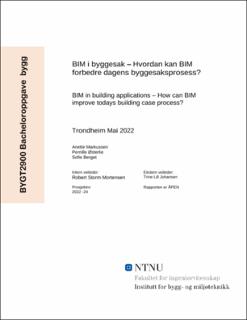| dc.contributor.advisor | Mortensen, Robert Storm | |
| dc.contributor.advisor | Johansen, Trine Lill | |
| dc.contributor.author | Østerlie, Pernille | |
| dc.contributor.author | Berget, Sofie | |
| dc.contributor.author | Markussen, Anette | |
| dc.date.accessioned | 2022-07-06T17:19:22Z | |
| dc.date.available | 2022-07-06T17:19:22Z | |
| dc.date.issued | 2022 | |
| dc.identifier | no.ntnu:inspera:106805903:113144373 | |
| dc.identifier.uri | https://hdl.handle.net/11250/3003222 | |
| dc.description.abstract | Bacheloroppgaven er skrevet på vegne av byggesakskontoret i Trondheim kommune. Byggesakskontoret har i løpet av de siste årene innført et saksbehandlingssystem som tilrettelegger for digitale søknader. Selv om andelen digitale søknader i stor grad har økt og fortsatt øker, har BIM sett seg utelatt av søknadene. Dette leder oss til spørsmålet som inngår i problemstillingen: Hvordan kan BIM forbedre dagens byggesaksprosess?
Basert på dette er det ønskelig å se nærmere på hvorfor BIM ikke sendes inn med søknader som er ansvarsbelagt, kartlegge holdningene til både byggesakskontoret og det private, og se på muligheter BIM kan gi.
For å kartlegge BIM i byggesaksbehandlingen er byggesaken blitt «fulgt» fra søknad og videre til kart- og matrikkelføring, samt sett på hvorvidt BIM kan brukes i den politiske behandlingen av byggesaker. Det er vel og merke først- og sistnevnte som er tillagt størst vekt i oppgaven. Innsamlet informasjon er hentet fra spørreundersøkelser gjennomført ved byggesakskontoret og blant politikere i bygningsrådet. Henholdsvis et utvalg på 11 og 5 respondenter. Det har også blitt innhentet informasjon gjennom samtaler med mange dyktige fagfolk og ansvarlige søkere i privat sektor.
Vår erfaring viser seg at bruk av BIM i saksbehandling har stor nytteverdi. Det gir saksbehandler et bedre grunnlag for å vurdere tiltak, det effektiviserer matrikkelføringen og gir muligheter for raskere oppdatert felles kartdatabase (FKB). Forutsigbarhet for søker øker, og det finnes besparelser både for kommune og for søker. Det må likevel videreutvikles gode tekniske løsninger som gjør prosessen med å lage og ta imot byggesaksBIM-er smidigere. | |
| dc.description.abstract | This bachelor thesis is written on behalf of the building case office in Trondheim municipality. The building case office has in the most recent years implemented a case management system that facilitate digital applications. Even though the fraction of digital applications has increased, building information models (BIM) is nowhere to be found in the applications. This leads us to the question: How can BIM improve todays building case process?
Based on this, it is desirable to look into why BIM does not get sent in along with applications with liability, map out the opinions the building case office and in the private sector has to this topic, and find the potential opportunities BIM has.
To further look into BIM in the building case process, the building case have been “followed” from application to mapping and updating of the Norwegian cadaster. There have also been looked into if BIM can be used in the political managing of building cases. The information that has been collected is from surveys done among workers in the building case office and in the building council, and from many competent professionals and responsible applicants in the private sector.
The use of BIM in case-processing shows to have great value. It gives the case workers a better basis to assess the building projects, it can streamline updating of the cadaster and gives opportunities to update the common map database (FKB) quicker. The predictability for responsible applicants increases and there exists savings for both the municipality and the applicants. Yet, the technical solutions must be further developed to make the process of both making and receive a BIM smoother. | |
| dc.language | nob | |
| dc.publisher | NTNU | |
| dc.title | BIM i byggesak – Hvordan kan BIM forbedre dagens byggesaksprosess? | |
| dc.type | Bachelor thesis | |
